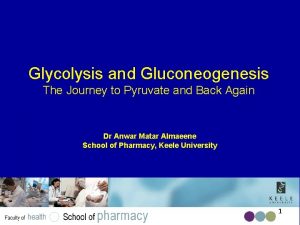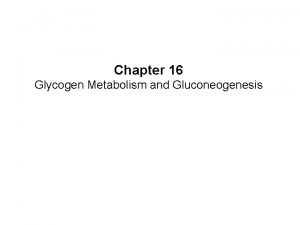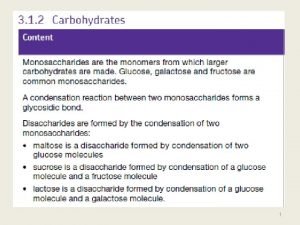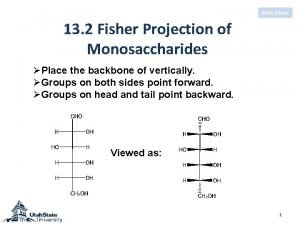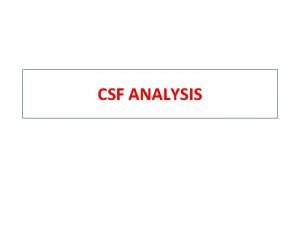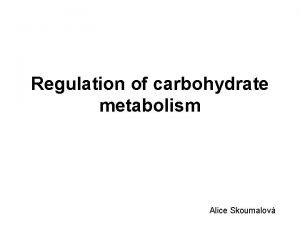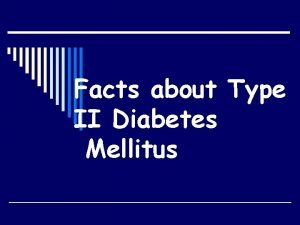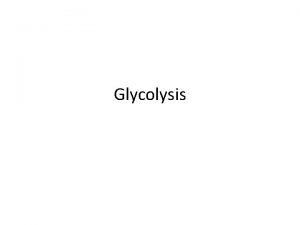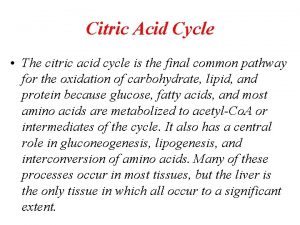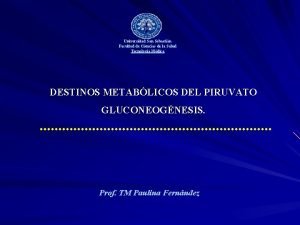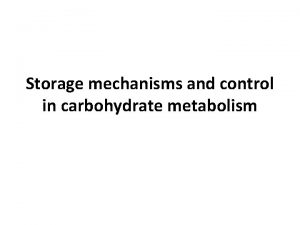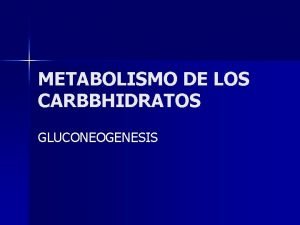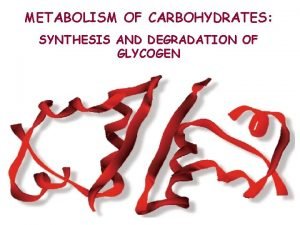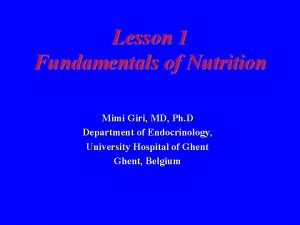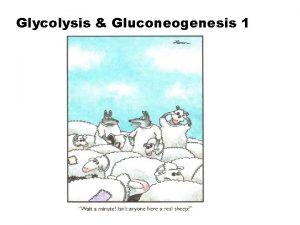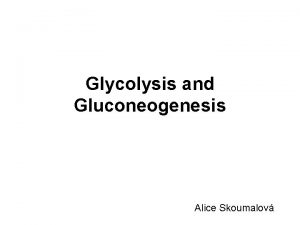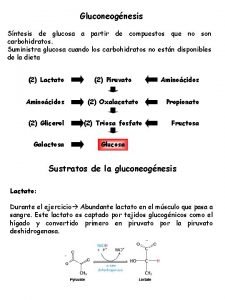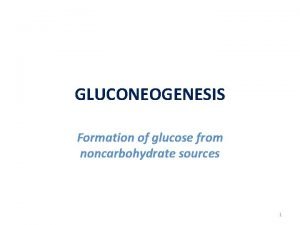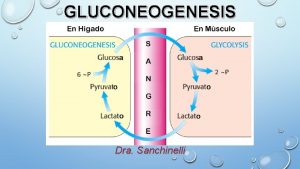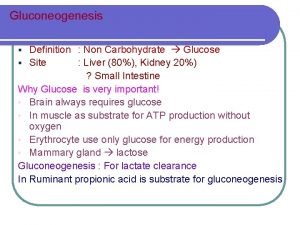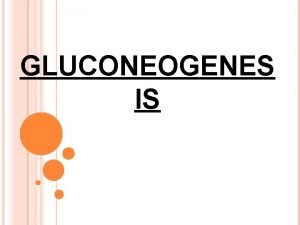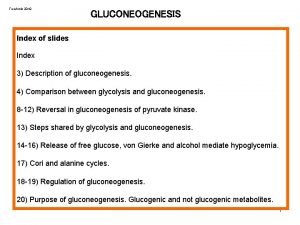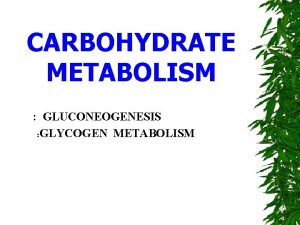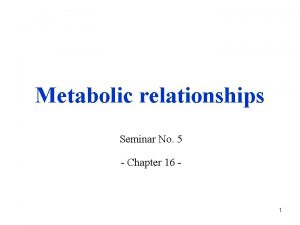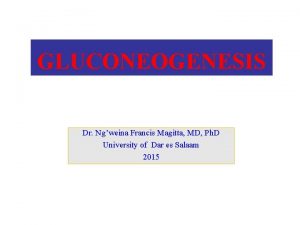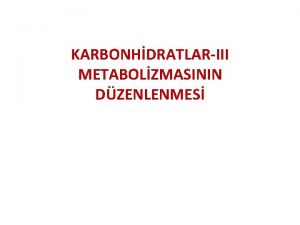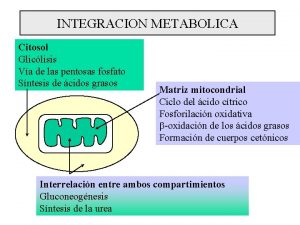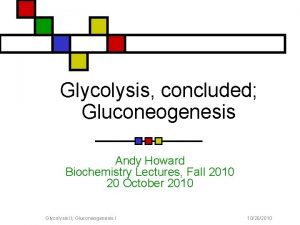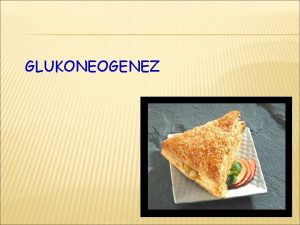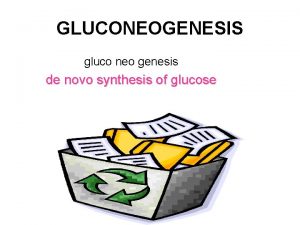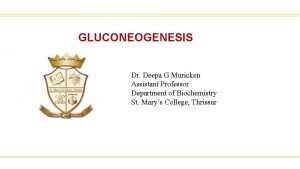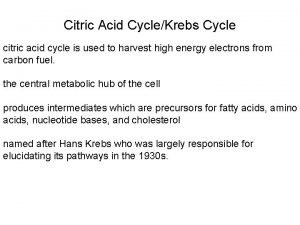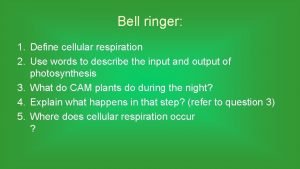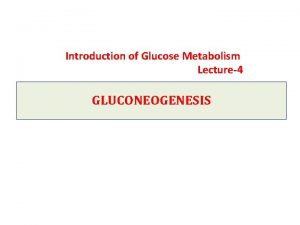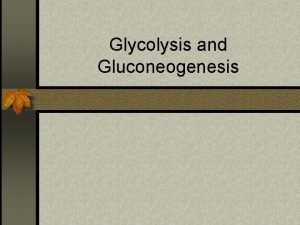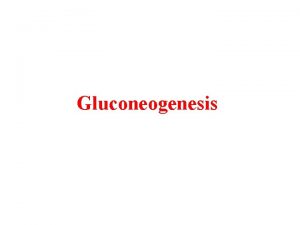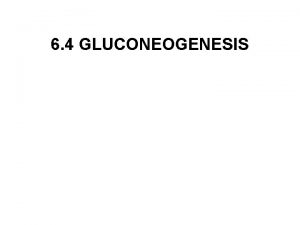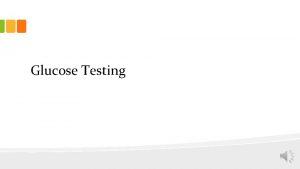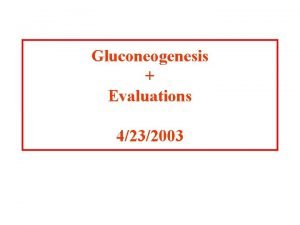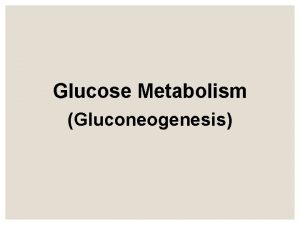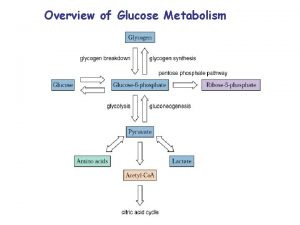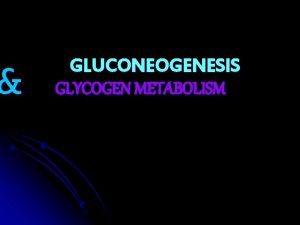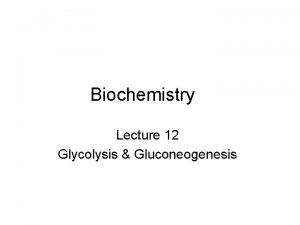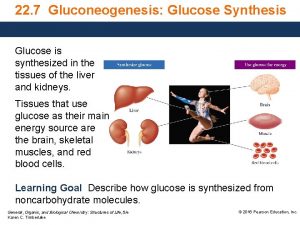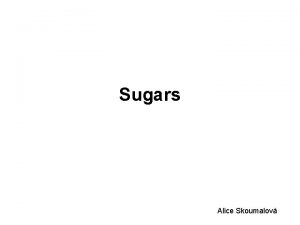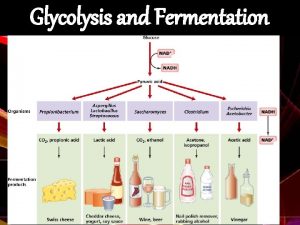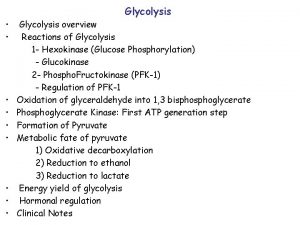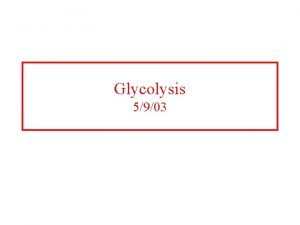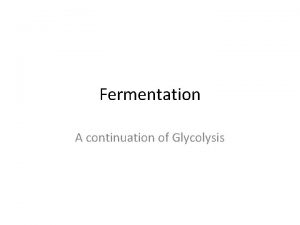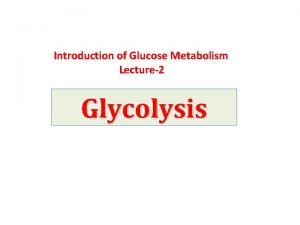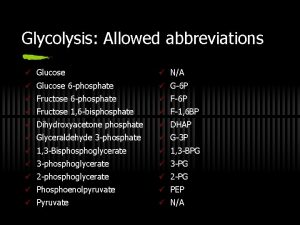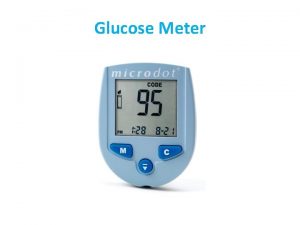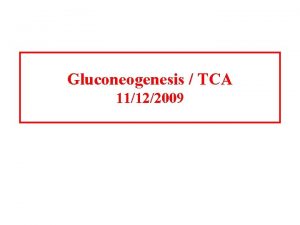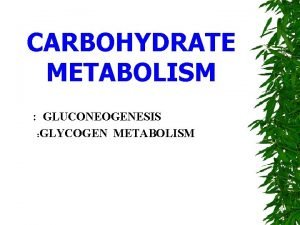Glycolysis and Gluconeogenesis Alice Skoumalov 1 Glycolysis Glucose



































- Slides: 35

Glycolysis and Gluconeogenesis Alice Skoumalová


1. Glycolysis

Glucose: the universal fuel for human cells Sources: Ø diet (the major sugar in our diet) Ø internal glycogen stores Ø blood (glucose homeostasis) Glucose oxidation: Ø after a meal: almost all tissues Ø during fasting: brain, erythrocytes

Glycolysis: Ø oxidation and cleavage of glucose Ø ATP generation (with and without oxygen) Ø all cells Ø in the cytosol (the reducing equivalents are transferred to the electron-transport chain by the shuttle) ATP is generated: 1. via substrate-level phosphorylation 2. from NADH 3. from oxidation of pyruvate Regulation of glycolysis: 1. Hexokinase 2. Phosphofructokinase 3. Pyruvate Kinase Generation of precursors for biosynthesis: Ø fatty acids Ø amino acids Ø ribosis-5 -P

Anaerobic glycolysis Øa limited supply of O 2 Øno mitochondria Øincreased demands for ATP Lactic acidemia Øin hypoxia

Phosphorylation of glucose: Ø irreversible Glucose 6 -P: Ø cannot be transported back across the plasma membrane Ø a precursor for many pathways that uses glucose Hexokinases Glucokinase (liver, β-cell of the pancreas) Ø high Km

Michaelis-Menten kinetics

1. Conversion of glucose 6 -P to the triose phosphates 2. Oxidation and substrate-level phosphorylation

1. Conversion of glucose 6 -P to the triose phosphates essential for the subsequent cleavage • irreversible • regulation

2. Oxidation and substrate-level phosphorylation Substrate-level phophorylation

Summary of the glycolytic pathway: Glucosis + 2 NAD+ + 2 Pi + 2 ADP 2 pyruvate + 2 NADH + 4 H+ + 2 ATP + 2 H 2 O ∆G 0´ = - 22 kcal (it cannot be reversed without the expenditure of energy!)

Clinical correlations: Hypoxemia (lack of oxygen in tissues) ØAcute hemorrhage (hypotension, lost of erythrocytes) - anaerobic glycolysis - lactate formation, metabolic acidosis ØChronic obstructive pulmonary disease (an insuficient ventilation) - anaerobic glycolysis, lactate formation, metabolic acidosis - accumulation of CO 2, respiratory acidosis ØMyocardial infarction (lack of oxygen in myocardium) - anaerobic glycolysis, lactate formation - lack of ATP

Aerobic glycolysis: Ø involving shuttles that transfer reducing equivalents across the mitochondrial membrane

Glycerol 3 -phosphate shuttle:

Malate-aspartate shuttle:

Anaerobic glycolysis: dissociation and formation of H+ Energy yield 2 mol of ATP

Major tissues of lactate production: (in a resting state) Daily lactate production 115 (g/d) Erythrocytes 29 Skin 20 Brain 17 Sceletal muscle 16 Renal medulla 15 Intestinal mucosa 8 Other tissues 10

Cori cycle: Lactate can be further metabolized by: Ø heart, sceletal muscle Lactate dehydrogenase: a tetramer (subunits M and H)

Lactate dehydrogenase Pyruvate + NADH + H+ LD lactate + NAD+ 5 isoenzymes: Heart (lactate) Muscle (pyruvate)

Biosynthetic functions of glycolysis:

Clinical correlations: Long-intensity exercise (for example a sprint) - the need for ATP exceeds the capacity of the mitochondria for oxidative phosphorylation, anaerobic glycolysis → lactate formation, muscle fatigue and pain - a training → the amounts of mitochondria and myoglobin increase

Regulation

• tissue-specific isoenzymes (low Km, a high afinity) • glucokinase (high Km) • the rate-limiting, allosteric enzyme • tissue-specific isoenzymes Fructose 2, 6 -bis-phosphate: Ø is not an intermediate of glycolysis! Ø Phosphofructokinase-2: inhibited through phosphorylation - c. AMP-dependent protein kinase (inhibition of glycolysis during fasting-glucagon)

the liver isoenzyme - inhibition by c. AMP-dependent protein kinase (inhibition of glycolysis during fasting) Lactic acidemia: increased NADH/NAD+ ratio inhibition of pyruvate dehydrogenase

2. Gluconeogenesis

Gluconeogenesis: Ø synthesis of glucose from noncarbohydrate precursors → to maintain blood glucose levels during fasting Ø liver, kidney Ø fasting, prolonged exercise, a highprotein diet, stress Specific pathways: 1. Pyruvate → Phosphoenolpyruvate 2. Fructose-1, 6 -P → Fructose-6 -P 3. Glucose-6 -P → Glucose

Precursors for gluconeogenesis 1. lactate (anaerobic glycolysis) 2. amino acids (muscle proteins) 3. glycerol (adipose tissue)

Conversion of pyruvate to phosphoenolpyruvate 1. Pyruvate → Oxaloacetate Ø Pyruvate carboxylase 2. Oxaloacetate → PEP Ø Phosphoenolpyruvatecarboxykinase

Conversion of phosphoenolpyruvate to glucose 3. Fructose-1, 6 -P → Fructose-6 -P Ø Fructose 1, 6 -bisphosphatase (cytosol) 4. Glucose-6 -P → Glucose Ø Glucose 6 -phosphatase (ER)

Clinical correlations: Alcoholism - excessive ethanol consumption → increase NADH/NAD+ ratio that drive the lactate dehydrogenase reaction toward lactate - lack of precursors for gluconeogenesis → its inhibition - insuficient diet - reduced glucose in the blood, consumption of glycogen in the liver → hypoglycemia

Regulation of gluconeogenesis: Ø concomitant inactivation of the glycolytic enzymes and activation of the enzymes of gluconeogenesis 1. Pyruvate → PEP Phosphoenolpyruvate carboxykinase induced by glucagon, epinephrine, and cortisol 2. Fructose 1, 6 -P → Fructose 6 -P Fructose 1, 6 -bisphosphatase - inhibited by fructose 2, 6 -P 3. Glucose 6 -P → Glucose 6 -phosphatase - induced during fasting


Summary Glycolysis • Generation of ATP (with or without oxygen) • The role of glycolysis in different tissues • Lactate production • Regulation Gluconeogenesis • Activation during fasting, prolonged exercise, after a highprotein diet • Precursors: lactate, glycerol, amino acids • 3 key reactions: Pyruvate → PEP Fructose-1, 6 -P→ Fructose-6 -P Glucose-6 -P → Glucose • Regulation

Pictures used in the presentation: Marks´ Basic Medical Biochemistry, A Clinical Approach, third edition, 2009 (M. Lieberman, A. D. Marks)
 Three stages of glycolysis
Three stages of glycolysis Glycogen structure
Glycogen structure Difference between alpha and beta glucose
Difference between alpha and beta glucose Sorbose fischer projection
Sorbose fischer projection Glucose in csf
Glucose in csf God-pod method normal range
God-pod method normal range Glycogenolysis and gluconeogenesis
Glycogenolysis and gluconeogenesis Glycogenolysis and gluconeogenesis
Glycogenolysis and gluconeogenesis Krebs cycle and gluconeogenesis
Krebs cycle and gluconeogenesis Krebs cycle and gluconeogenesis
Krebs cycle and gluconeogenesis Precursores de gluconeogenesis
Precursores de gluconeogenesis Difference between glycolysis and pentose phosphate pathway
Difference between glycolysis and pentose phosphate pathway Sustratos gluconeogenicos
Sustratos gluconeogenicos Glucose-alanine cycle
Glucose-alanine cycle Gluconeogenesis purpose
Gluconeogenesis purpose G=rt ln(q/k)
G=rt ln(q/k) Precursor of gluconeogenesis
Precursor of gluconeogenesis Ciclo de sustrato
Ciclo de sustrato The production of glucose from noncarbohydrate sources
The production of glucose from noncarbohydrate sources Gluconeogenesis regulacion
Gluconeogenesis regulacion Gluconeogenesis definition
Gluconeogenesis definition Converting amino acids to glucose
Converting amino acids to glucose Net reaction of gluconeogenesis
Net reaction of gluconeogenesis Net reaction of gluconeogenesis
Net reaction of gluconeogenesis Gluconeogenesis from lactate
Gluconeogenesis from lactate Gluconeogenesis from lactate
Gluconeogenesis from lactate Gluconeogenesis nedir
Gluconeogenesis nedir Degradacion de trigliceridos
Degradacion de trigliceridos Phosphofructokinase 1 is inhibited by
Phosphofructokinase 1 is inhibited by Gluconeogene
Gluconeogene Neo gluconeogenesis
Neo gluconeogenesis Pyruvate carboxylase gluconeogenesis
Pyruvate carboxylase gluconeogenesis Insulin and glycolysis
Insulin and glycolysis Insulin and glycolysis
Insulin and glycolysis Output of citric acid cycle
Output of citric acid cycle Input of krebs cycle
Input of krebs cycle
